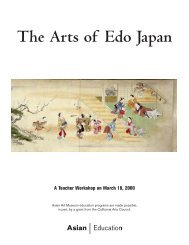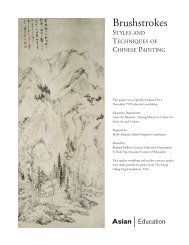Sacred Arts of Tibet (.pdf) - Asian Art Museum | Education
Sacred Arts of Tibet (.pdf) - Asian Art Museum | Education
Sacred Arts of Tibet (.pdf) - Asian Art Museum | Education
You also want an ePaper? Increase the reach of your titles
YUMPU automatically turns print PDFs into web optimized ePapers that Google loves.
<strong>Sacred</strong> <strong><strong>Art</strong>s</strong> <strong>of</strong> <strong>Tibet</strong><br />
receive high graduate degrees such as the Geshe (doctoral) degree. Each <strong>of</strong> the larger monasteries contained<br />
separate colleges specializing in such fields as ritual, philosophy, meditation or medicine. Monks in<br />
<strong>Tibet</strong> have always enjoyed a measure <strong>of</strong> freedom that contrasts sharply with their Western counterparts.<br />
They could seek teachers <strong>of</strong> their own choice, return to their family’s home, live in their own home,<br />
transfer to other monasteries or enter into solitary meditation retreats. The Buddhist religion demands<br />
intellectual integrity and independent thought above adherence to any doctrine or authority. This made<br />
traditional <strong>Tibet</strong> a peaceful and spiritual society, but has now proved disastrous in the face <strong>of</strong> the Chinese<br />
penchant for absolute obedience to arbitrary authority.<br />
The monasteries were the cultural and administrative centers <strong>of</strong> <strong>Tibet</strong>. They were primarily the places <strong>of</strong><br />
worship and religious training, but they were also the preservers <strong>of</strong> tradition. They were the centers <strong>of</strong><br />
learning and the arts as well as the libraries and printing houses (see Slide 7, 8, and 12). They provided<br />
social welfare to the needy in the way <strong>of</strong> orphanages and retirement homes. The monasteries had their<br />
own lands, which were worked by hired laborers; these laborers were paid by the monasteries, thus fulfilling<br />
a role similar to that <strong>of</strong> farm workers in America and Europe. The monasteries were self-contained<br />
communities complete with elected leaders and bureaucracies. The largest, Drepung Monastery near<br />
Lhasa, had over 10,000 monks at one time.<br />
In fact, what made the <strong>Tibet</strong>an system unique is that the religious and secular systems were thoroughly<br />
mixed together right up to modern times. This unification is best represented in the figure <strong>of</strong> the Dalai<br />
Lama, who, from the sixteenth century until today, is viewed by <strong>Tibet</strong>ans as both their spiritual and political<br />
leader. His winter palace in Lhasa, the Potala, held the highest <strong>of</strong>fices <strong>of</strong> both the lay and monastic<br />
<strong>of</strong>ficials who comprised the central government <strong>of</strong> <strong>Tibet</strong>. This complete blending <strong>of</strong> the two worlds permeates<br />
all aspects <strong>of</strong> <strong>Tibet</strong>an life and thought, producing an essentially spiritual outlook. One important<br />
expression <strong>of</strong> wealth is the commissioning <strong>of</strong> religious statues <strong>of</strong> precious metals and paintings <strong>of</strong> exquisite<br />
workmanship to be kept in the family shrine or donated to a monastery or temple. Religious art is thus<br />
close to the heart <strong>of</strong> all <strong>Tibet</strong>ans.<br />
This historical role <strong>of</strong> monasteries no longer exists in <strong>Tibet</strong>. Since the invasion in 1959, most <strong>of</strong> the 6,000<br />
monasteries have been destroyed. The remaining monasteries are run by a skeleton crew <strong>of</strong> monks who<br />
are forced to perform on demand for tourists. Parents who want to send their children to be educated in<br />
monasteries <strong>of</strong>ten leave <strong>Tibet</strong> to join the growing exile communities in India and elsewhere.<br />
8<br />
<strong>Asian</strong> <strong>Art</strong> <strong>Museum</strong>
















